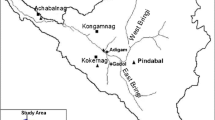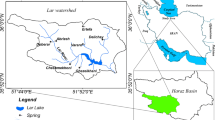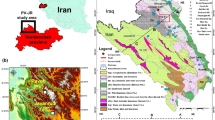Abstract
In this study, the hydro-geochemistry and stable isotope compositions (δ18O, δ2H, and δ13C) of travertine-depositing springs were investigated in two regions of Garab and Pamukkale, located in NE-Iran and SW-Turkey, respectively. The physical, chemical and isotopic dataset of water and travertine samples were obtained in situ measurements, laboratory analysis and from the literature. According to the high EC values (~ 2400 and ~ 10,500 μS/cm), the average δ13C-DIC values of water samples (10.4 and 7.2‰ VPDB), and its δ13C–CO2 values (1.5 and − 1.8‰ VPDB), it seems that the Garab and Pamukkale spring water were supplying from deep thermal groundwater with thermogenic origins and with contribution of carbonate dissolution through the rock-water interactions process. The more concentrations of Na+, K+, and Cl− in Garab water are related to subsequent admixture processes, which is originated from dissolving overloaded impure dissolve materials during upwelling water toward the ground level. The more enriched δ13C and δ18O values of Garab travertine samples (10.4 and − 7.1‰ VPDB, respectively) than that of Pamukkale travertine (7.2 and − 10.4‰ VPDB, respectively) is due to more CO2 degassing. The isotopic compositions of precipitation in both Garab (δ2H = 7.2∗δ18O + 11.2‰) and Pamukkale (δ2H = 8∗δ18O + 16‰) areas are characterized by greater d-excess compared to GMWL but smaller than of Mediterranean area. Although the isotopic compositions of both Garab and Pamukkale springs show the meteoric origin; however, the deviation from meteoric water lines is probably evident to oxygen isotope exchange with the deep host bedrock.







Similar content being viewed by others
References
Alçiçek H, Varol B, Özkul M (2007) Sedimentary facies, depositional environments and palaeogeographic evolution of the Neogene Denizli Basin, SW Anatolia. Turk Sediment Geol 202:596–637
Altunel E (1994) Active tectonics and the evolution of Quaternary travertines at Pamukkale, Western Turkey. PhD thesis, University of Bristol, p 236
Altunel E, Hancock PL (1993) Morphology and structural setting of Quaternary travertines at Pamukkale, Turkey. Geol J 28(3–4):335–346
Anzalone E, Ferreri V, Sprovieri M, D’Argenio B (2007) Travertines as hydrologic archives: the case of the Pontecagnano deposits (southern Italy). Adv Water Resour 30(10):2159–2175
Atabey E (2002) The formation of fissure ridge type laminated travertine-tufa deposits microscopical cheacteristics and diagenesis, Kirşehir, central Anatolia. Bull Mineral Res Explor Inst Turkey 123–124:59–70
Bayari CS, Pekkan E, Ozyurt NN (2009) Obruks, as giant collapse dolines caused by hypogenic karstification in central Anatolia, Turkey: analysis of likely formation processes. Hydrogeol J 17(2):327–345
Brogi A, Capezzuoli E (2009) Travertine deposition and faulting: the fault-related travertine fissure-ridge at Terme S. Giovanni, Rapolano Terme (Italy). Int J Earth Sci 98(4):931–947
Brogi A, Capezzuoli E, Aqué R, Branca M, Voltaggio M (2010) Studying travertines for neotectonics investigations: middle-Late Pleistocene syn-tectonic travertine deposition at Serre di Rapolano (Northern Apennines, Italy). Int J Earth Sci 99(6):1383–1398
Çakır Z (1999) Along-strike discontinuity of active normal faults and its influence on quaternary travertine deposition: examples from western Turkey. Turk J Earth Sci 8:67–80
Chafetz HS, Guidry SA (2003) Deposition and diagenesis of mammoth hot springs travertine, yellowstone National Park, Wyoming, USA. Can J Earth Sci 40(11):1515–1529
Clark ID, Fritz P (1997) Environmental isotopes in hydrogeology. Lewis Publishers, Boca Raton, FL, p 328
Craig H (1961) Isotopic variation in meteoric waters. Sci N.Y. 133:1702–1703
Crossey LJ, Fischer TP, Patchett PJ, Karlstrom KE, Hilton DR, Newell DL, Huntoon P, Reynolds AC, de Leeuw GAM (2006) Dissected hydrologic system at the Grand Canyon; interaction between deeply derived fluids and plateau aquifer waters in modern springs and travertine. Geology 34(1):25–28
Di Benedetto F, Montegrossi G, Minissale A, Pardi LA, Romanelli M, Tassi F, Delgado Huertas A, Pampin EM, Vaselli O, Borrini D (2011) Biotic and inorganic control on travertine deposition at Bullicame 3 spring (Viterbo, Italy): a multidisciplinary approach. Geochim Cosmochim Acta 75:4441–4455
Dilsiz C (2006) Conceptual hydrodynamic model of the Pamukkale hydrothermal field, southwestern Turkey, based on hydrochemical and isotopic data. Hydrogeol J 14(4):562–572
Domínguez-Villar D, Vázquez-Navarro JA, Krklec K (2017) The role of gypsum and/or dolomite dissolution in tufa precipitation: lessons from the hydrochemistry of a carbonate–sulphate karst system. Earth Surf Proc Land 42(2):245–258
Ekmekçi M, Günay G, Şimşek Ş (1995) Morphology of rim stone pools, Pamukkale, western Turkey. Cave Karst Sci 22:103–106
Filiz S (1984) Investigation of the important geothermal areas by using C, H, O isotopes. In: Proceeding of the utilization of geothermal energy for electric power generation and space heating, Florence, Italy. Ref. No. EP/SEM.9/R.3
Flores Márquez EL, Jiménez-Suárez G, Martínez-Serrano RG, Chávez RE, Silva-Pére D (2006) Study of geothermal water intrusion due to groundwater exploitation in the Puebla Valley aquifer system, Mexico. Hydrogeol J 14(7):1216–1230
Gat JR, Carmi I (1970) Evolution in the isotopic composition of atmospheric waters in the Mediterranean Sea area. J Geophys Res 75:3039–3048
Goleij F, Mahboubi A, Khanehbad M, Moussavi- Harami R (2018) Sedimentology and hydro-geochemistry of Garab travertines in southeast of Mashhad, Iran. Geopersia 8(2):157–170
Han GL, Liu CQ (2004) Water geochemistry controlled by carbonate dissolution: a study of the river waters draining karst-dominated terrain, Guizhou Province, China. Chem Geol 204:1–21
Han GL, Tang Y, Xu ZF (2010) Fluvial geochemistry of rivers draining karst terrain in southwest China. J Asian Earth Sci 38:65–75
Hancock PL, Altunel E (1997) Faulted archaeological relies at Hierapolis (Pamukkale), Turkey. J Geodyn 24:21–36
Herhsey RL, Mizell SA, Earman S (2010) Chemical and physical characteristics of springs dischargingfrom regional flow systems of the carbonate-rock province of the Great Basin, western United States. Hydrogeol J 18(4):1007–1026
Heydarizad M, Raeisi E, Sorí R, Gimeno L (2019) Developing meteoric water lines for Iran based on air masses and moisture sources. Water 11(11):2359
Hoefs J (1997) Stable isotope geochemistry. Springer, Berlin. p, p 201
Karimpour MH, Stern CR, Farmer GL (2010) Zircon U-Pb geochronology, Sr-Nd isotope analyses, and petrogenetic study of the Dehnow diorite and Kuhsangi granodiorite (Paleo-Tethys), NE Iran. J Asian Earth Sci 37:384–393
Kele S, Özkul M, Fórizs I, Gökgöz A, Baykara MO, Alçiçek MC, Németh T (2011) Stable isotope geochemical study of Pamukkale travertines: new evidences of low-temperature non-equilibrium calcite water fractionation. Sed Geol 238:191–212
Keshavarzi B, Moore F, Mosaferi M, Rahmani F (2011) The source of natural arsenic contamination in groundwater, west of Iran. Water Qual Expos Health 3:135–147
Lang YC, Liu CQ, Zhao ZQ, Li SL, Han GL (2006) Geochemistry of surface and ground water in Guiyang, China: water/rock interaction and pollution in a karst hydrological system. Appl Geochem 21(6):887–903
Ma R, Wang Y, Sun Z, Zheng C, Ma T, Prommer H (2011) Geochemical evolution of groundwater in carbonate aquifers in Taiyuan, northern China. Appl Geochem 26:884–897
Mansouri Daneshvar MR (2015) Climatic impacts on hydrogeochemical characteristics of mineralized springs: a case study of the Garab travertine zone in the northeast of Iran. Arab J Geosci 8(7):4895–4906
Mansouri Daneshvar MR, Pourali M (2015) Hydrogeochemical and geomorphological investigation of travertine deposition in the Garab Spring region, NE Iran. Sustain Water Resour Manag 1(3):253–262
Minissale A, Kerrick DM, Magro G, Murrell MT, Paladini M, Rihs S, Sturchio NC, Tassi F, Vaselli O (2002) Geochemistry of Quaternary travertines in the region north of Rome (Italy): structural, hydrologic and paleoclimatic implications. Earth Planet Sci Lett 203(2):709–728
Mohammadzadeh H (2009) The quality and isotope geochemistry of Garow saline water springs, Mashhad-Iran. Proc Goldschmidt Conf 73(13S):A891
Mohammadzadeh H (2010) The meteoric relationship for 18O and 2H in precipitations and isotopic compositions of water resources in Mashhad area (NE Iran): the first Azad university international geology conference. Mashhad, pp 555–559
Mohammadzadeh H, Clark ID (2011) Bioattenuation in groundwater impacted by landfill leachate traced with δ13C. Ground Water 49(6):880–890
Mohammadzadeh H, Heydarizad M (2019) δ18O and δ2H characteristics of moisture sources and their role in surface water recharge in the north-east Iran. Isot Environ Health Stud 55(6):550–565
Mohammadzadeh H, Kazemi M (2017) Geofluids assessment of the Ayub and Shafa hot springs in Kopet-Dagh zone (NE Iran): an isotopic geochemistry approach. Geofluids. https://doi.org/10.1155/2017/6358680
Mohammadzadeh H, Clark ID, Marschner M, St-Jean G (2005) Compound specific isotopic analysis (CSIA) of landfill leachate DOC components. Chem Geol 218:3–13
Özkul M, Varol B, Alçiçek MC (2002) Depositional environments and petrography of denizli travertines. Miner Res Explor Bull 125:13–29
Özkul M, Gökgöz A, Horvatinčić N (2010) Depositional properties and geochemistry of Holocene perched springline tufa deposits and associated spring waters: a case study from the Denizli province, Western Turkey. In: Pedley HM (ed) Tufas and speleothems: unravelling the microbial and physical controls, the geological society, London. Special Publications vol 336, pp 245–262
Özkul M, Kele S, Gökgöz A, Shen CC, Jones B, Baykara MO, Fόrizs I, Németh T, Chang YW, Alçiçek MC (2013) Comparison of the quaternary travertine sites in the Denizli extensional basin based on their depositional and geochemical data. Sed Geol 294:179–204
Özler HM (2000) Water balance and water quality in the Çürüksu basin, western Turkey. Hydrogeol J 7(4):405–418
Panichi C, Tongiorgi E (1976) Carbon isotopic composition of CO2 from springs, fumaroles, mofettes and travertines of central and southern Italy: a preliminary prospection method of geothermal areas. In: Proceedings of the 2nd U.N. symposium on the development and use of geothermal energy, San Francisco, 20–29 May 1975, pp 815–825
Pazand K, Hezarkhani A, Ghanbari Y, Aghavali N (2012) Groundwater geochemistry in the Meshkinshahr basin of Ardabil province in Iran. Environ Earth Sci 65:871–879
Pedley HM (2009) Tufas and travertines of the Mediterranean region: a testing ground for freshwater carbonate concepts and developments. Sedimentology 56:221–246
Pentecost A (2005) Travertine. Springer Verlag, Berlin, p 445
Petitta M, Primavera P, Tuccimei P, Aravena R (2011) Interaction between deep and shallow groundwater systems in areas affected by quaternary tectonics (Central Italy): a geochemical and isotope approach. Environ Earth Sci 63(1):11–30
Piper AM (1944) A graphic procedure in the geochemical interpretation of water analysis. Trans Am Geophys Union 25(6):914–923
Ryu JS, Lee KS, Chang HW (2007) Hydrogeochemical and isotopic investigations of the Han River Basin, South Korea. J Hydrol 345:50–60
Şimşek Ş (2003) Hydrogeological and isotopic survey of geothermal fields in the Büyük Menderes graben, Turkey. Geothermics 32:669–678
Şimşek S, Günay G, Elhatip H, Ekmekçi M (2000) Environmental protection of geothermal waters and travertines at Pamukkale, Turkey. Geothermics 29:557–572
Uysal T, Feng Y, Zhao J, Altunel E, Weatherley D, Karabacak V, Cengiz O, Golding SD, Lawrence MG, Collerson KD (2007) U-series dating and geochemical tracingof late Quaternary travertines in co-seismic fissures. Earth Planet Sci Lett 257:450–462
Von Eynatten H, Pawlowsky-Glahn V, Egozcue JJ (2002) Understanding perturbation on the simplex: a simple method to better visualize and interpret compositional data in ternary diagrams. Math Geol 34(3):249–257
Yoshimura K, Liu Z, Cao J, Yuan D, Inokura Y, Noto M (2004) Deep source CO2 in natural waters and its role in extensive tufa deposition in the Huanglong Ravines, Sichuan, China. Chem Geol 205:141–153
Zedef V, Russell MJ, Fallick AE, Hall AJ (2000) Genesis of vein stockwork and sedimentary magnesite and hydromagnesite deposits in the ultramafic terranes of southwestern Turkey: a stable isotope study. Econ Geol 95(2):429–445
Zeraatkar K, Rahimi B (2012) Survey of Sangbast-Shandiz fault zone growth and geomorphological results. J Geogr Reg Dev 10(19):196–214 (In Persian)
Zhang CL, Fouke BW, Bonheyo G, Peacock A, White DC, Huang Y, Romanek CS (2004) Lipid biomarkers and carbon-isotopes of modern travertine deposits (Yellowstone National Park, USA): implications for biogeochemical dynamics in hot-spring systems. Geochim Cosmochim Acta 68:3157–3169
Acknowledgements
We thank anonymous reviewers for technical suggestions on data interpretations.
Author information
Authors and Affiliations
Corresponding author
Additional information
Publisher's Note
Springer Nature remains neutral with regard to jurisdictional claims in published maps and institutional affiliations.
Rights and permissions
About this article
Cite this article
Mohammadzadeh, H., Mansouri Daneshvar, M.R. A comparison of hydro-geochemistry and stable isotope composition of travertine-depositing springs, Garab in NE Iran and Pamukkale in SW Turkey. Carbonates Evaporites 35, 23 (2020). https://doi.org/10.1007/s13146-020-00566-9
Accepted:
Published:
DOI: https://doi.org/10.1007/s13146-020-00566-9




